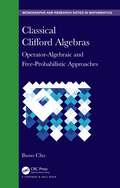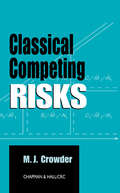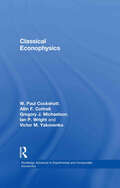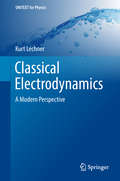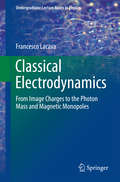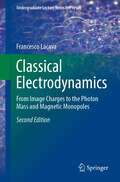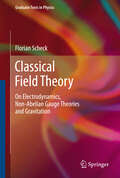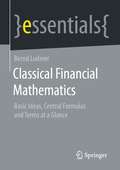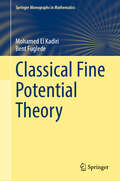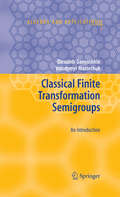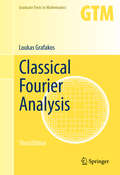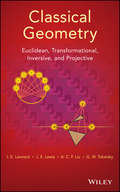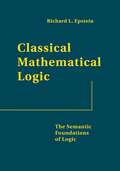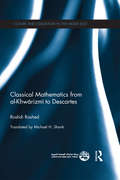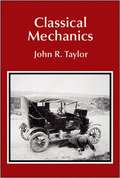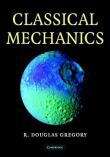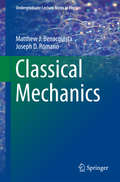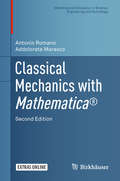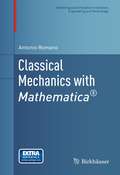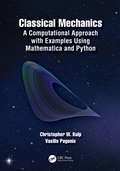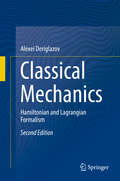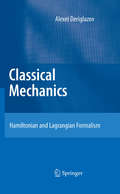- Table View
- List View
Classical Clifford Algebras: Operator-Algebraic and Free-Probabilistic Approaches (Chapman & Hall/CRC Monographs and Research Notes in Mathematics)
by Ilwoo ChoClassical Clifford Algebras: Operator-Algebraic and Free-Probabilistic Approaches offers novel insights through operator-algebraic and free-probabilistic models. By employing these innovative methods, the author sheds new light on the intrinsic connections between Clifford algebras and various mathematical domains. This monograph should be an essential addition to the library of any researchers interested in Clifford Algebras or Algebraic Geometry more widely.Features Includes multiple examples and applications Suitable for postgraduates and researchers working in Algebraic Geometry Takes an innovative approach to a well-established topic.
Classical Competing Risks
by Martin J. CrowderIf something can fail, it can often fail in one of several ways and sometimes in more than one way at a time. There is always some cause of failure, and almost always, more than one possible cause. In one sense, then, survival analysis is a lost cause. The methods of Competing Risks have often been neglected in the survival analysis literature.
Classical Econophysics (Routledge Advances in Experimental and Computable Economics #Vol. 2)
by Allin F. Cottrell Paul Cockshott Gregory John Michaelson Ian P. Wright Victor YakovenkoThis monograph examines the domain of classical political economy using the methodologies developed in recent years both by the new discipline of econo-physics and by computing science. This approach is used to re-examine the classical subdivisions of political economy: production, exchange, distribution and finance. The book begins by examining the most basic feature of economic life – production – and asks what it is about physical laws that allows production to take place. How is it that human labour is able to modify the world? It looks at the role that information has played in the process of mass production and the extent to which human labour still remains a key resource. The Ricardian labour theory of value is re-examined in the light of econophysics, presenting agent based models in which the Ricardian theory of value appears as an emergent property. The authors present models giving rise to the class distribution of income, and the long term evolution of profit rates in market economies. Money is analysed using tools drawn both from computer science and the recent Chartalist school of financial theory. Covering a combination of techniques drawn from three areas, classical political economy, theoretical computer science and econophysics, to produce models that deepen our understanding of economic reality, this new title will be of interest to higher level doctoral and research students, as well as scientists working in the field of econophysics.
Classical Electrodynamics: A Modern Perspective (UNITEXT for Physics)
by Kurt LechnerThis book addresses the theoretical foundations and the main physical consequences of electromagnetic interaction, generally considered to be one of the four fundamental interactions in nature, in a mathematically rigorous yet straightforward way. The major focus is on the unifying features shared by classical electrodynamics and all other fundamental relativistic classical field theories. The book presents a balanced blend of derivations of phenomenological predictions from first principles on the one hand, and concrete applications on the other. Further, it highlights the internal inconsistencies of classical electrodynamics, and addresses and resolves often-ignored critical issues, such as the dynamics of massless charged particles, the infinite energy of the electromagnetic field, and the limits of the Green’s function method. Presenting a rich, multilayered, and critical exposition on the electromagnetic paradigm underlying the whole Universe, the book offers a valuable resource for researchers and graduate students in theoretical physics alike.
Classical Electrodynamics: From Image Charges to the Photon Mass and Magnetic Monopoles (Undergraduate Lecture Notes in Physics)
by Francesco LacavaThis book proposes intriguing arguments that will enable students to achieve a deeper understanding of electromagnetism, while also presenting a number of classical methods for solving difficult problems. Two chapters are devoted to relativistic electrodynamics, covering all aspects needed for a full comprehension of the nature of electric and magnetic fields and, subsequently, electrodynamics. Each of the two final chapters examines a selected experimental issue, introducing students to the work involved in actually proving a law or theory. Classical books on electricity and magnetism are mentioned in many references, helping to familiarize students with books that they will encounter in their further studies. Various problems are presented, together with their worked-out solutions. The book is based on notes from special lectures delivered by the author to students during the second year of a BSc course in Physics, but the subject matter may also be of interest to senior physicists, as many of the themes covered are completely ignored or touched only briefly in standard textbooks.
Classical Electrodynamics: From Image Charges to the Photon Mass and Magnetic Monopoles (Undergraduate Lecture Notes in Physics)
by Francesco LacavaThis book presents an overview of Classical Electrodynamics. Its second edition includes new chapters that pick up where the material from the first edition left off. The image method introduced in the first edition is expanded to series of images, using simple examples like a point charge or a charged wire between two grounded plates, as well as more relevant examples such as two charged conducting spheres and the force between them. The topic of complex functions is broadened with the introduction of conformal mapping. One new chapter introduces the method of separation of variables, including in Cartesian coordinates (box with sides at fixed voltages), in spherical coordinates (dielectric and conducting sphere, potential of a charged ring), in cylindrical coordinates (conducting wedge, cylinder in uniform field). It also presents the potentials and the fields for a point charge in motion, radiation by a point charge and by a dipole, radiation reaction. Two other chapters present updated lessons on the mass of the photon and search for monopoles. Examples and/or solvable problems are provided throughout.
Classical Field Theory
by Horaƫiu NăstaseClassical field theory predicts how physical fields interact with matter, and is a logical precursor to quantum field theory. This introduction focuses purely on modern classical field theory, helping graduates and researchers build an understanding of classical field theory methods before embarking on future studies in quantum field theory. It describes various classical methods for fields with negligible quantum effects, for instance electromagnetism and gravitational fields. It focuses on solutions that take advantage of classical field theory methods as opposed to applications or geometric properties. Other fields covered includes fermionic fields, scalar fields and Chern–Simons fields. Methods such as symmetries, global and local methods, Noether theorem and energy momentum tensor are also discussed, as well as important solutions of the classical equations, in particular soliton solutions.
Classical Field Theory: On Electrodynamics, Non-Abelian Gauge Theories and Gravitation (Graduate Texts in Physics)
by Florian ScheckThe book describes Maxwell's equations first in their integral, directly testable form, then moves on to their local formulation. The first two chapters cover all essential properties of Maxwell's equations, including their symmetries and their covariance in a modern notation. Chapter 3 is devoted to Maxwell theory as a classical field theory and to solutions of the wave equation. Chapter 4 deals with important applications of Maxwell theory. It includes topical subjects such as metamaterials with negative refraction index and solutions of Helmholtz' equation in paraxial approximation relevant for the description of laser beams. Chapter 5 describes non-Abelian gauge theories from a classical, geometric point of view, in analogy to Maxwell theory as a prototype, and culminates in an application to the U(2) theory relevant for electroweak interactions. The last chapter 6 gives a concise summary of semi-Riemannian geometry as the framework for the classical field theory of gravitation. The chapter concludes with a discussion of the Schwarzschild solution of Einstein's equations and the classical tests of general relativity (perihelion precession of Mercury, and light deflection by the sun). ------ Textbook features: detailed figures, worked examples, problems and solutions, boxed inserts, highlighted special topics, highlighted important math etc., helpful summaries, appendix, index.
Classical Financial Mathematics: Basic Ideas, Central Formulas and Terms at a Glance (essentials)
by Bernd LudererThis essential teaches basic formulas, methods and ideas of classical financial mathematics. Since classical financial mathematics makes do with elementary mathematical tools, any interested reader with average mathematical school knowledge can easily follow this text. The core of the text is the calculation of interest and compound interest, annuity calculation, amortization calculation and price calculation. A large number of practical examples illustrate the mathematical questions.This Springer essential is a translation of the original German 1st edition essentials, Klassische Finanzmathematik by Bernd Luderer, published by Springer Fachmedien Wiesbaden GmbH, part of Springer Nature in 2019. The translation was done with the help of artificial intelligence (machine translation by the service DeepL.com). A subsequent human revision was done primarily in terms of content, so that the book will read stylistically differently from a conventional translation. Springer Nature works continuously to further the development of tools for the production of books and on the related technologies to support the authors.
Classical Fine Potential Theory (Springer Monographs in Mathematics)
by Bent Fuglede Mohamed El KadiriThis comprehensive book explores the intricate realm of fine potential theory. Delving into the real theory, it navigates through harmonic and subharmonic functions, addressing the famed Dirichlet problem within finely open sets of R^n. These sets are defined relative to the coarsest topology on R^n, ensuring the continuity of all subharmonic functions. This theory underwent extensive scrutiny starting from the 1970s, particularly by Fuglede, within the classical or axiomatic framework of harmonic functions. The use of methods from fine potential theory has led to solutions of important classical problems and has allowed the discovery of elegant results for extension of classical holomorphic function to wider classes of “domains”. Moreover, this book extends its reach to the notion of plurisubharmonic and holomorphic functions within plurifinely open sets of C^n and its applications to pluripotential theory. These open sets are defined by coarsest topology that renders all plurisubharmonic functions continuous on C^n. The presentation is meticulously crafted to be largely self-contained, ensuring accessibility for readers at various levels of familiarity with the subject matter. Whether delving into the fundamentals or seeking advanced insights, this book is an indispensable reference for anyone intrigued by potential theory and its myriad applications. Organized into five chapters, the first four unravel the intricacies of fine potential theory, while the fifth chapter delves into plurifine pluripotential theory.
Classical Finite Transformation Semigroups: An Introduction (Algebra and Applications #9)
by Olexandr Ganyushkin Volodymyr MazorchukThe aim of this monograph is to give a self-contained introduction to the modern theory of finite transformation semigroups with a strong emphasis on concrete examples and combinatorial applications. It covers the following topics on the examples of the three classical finite transformation semigroups: transformations and semigroups, ideals and Green's relations, subsemigroups, congruences, endomorphisms, nilpotent subsemigroups, presentations, actions on sets, linear representations, cross-sections and variants. The book contains many exercises and historical comments and is directed first of all to both graduate and postgraduate students looking for an introduction to the theory of transformation semigroups, but also to tutors and researchers.
Classical Fourier Analysis (Graduate Texts in Mathematics #249)
by Loukas GrafakosThe main goal of this text is to present the theoretical foundation of the field of Fourier analysis on Euclidean spaces. It covers classical topics such as interpolation, Fourier series, the Fourier transform, maximal functions, singular integrals, and Littlewood-Paley theory. The primary readership is intended to be graduate students in mathematics with the prerequisite including satisfactory completion of courses in real and complex variables. The coverage of topics and exposition style are designed to leave no gaps in understanding and stimulate further study. This third edition includes new Sections 3. 5, 4. 4, 4. 5 as well as a new chapter on "Weighted Inequalities," which has been moved from GTM 250, 2nd Edition. Appendices I and B. 9 are also new to this edition. Countless corrections and improvements have been made to the material from the second edition. Additions and improvements include: more examples and applications, new and more relevant hints for the existing exercises, new exercises, and improved references. Reviews from the Second Edition: "The books cover a large amount of mathematics. They are certainly a valuable and useful addition to the existing literature and can serve as textbooks or as reference books. Students will especially appreciate the extensive collection of exercises. " Andreas Seager, Mathematical Reviews "This book is very interesting and useful. It is not only a good textbook, but also an i ndispensable and valuable reference for researchers who are working on analysis and partial differential equations. The readers will certainly benefit a lot from the detailed proofs and the numerous exercises. " Yang Dachun, zbMATH
Classical Geometry
by J. E. Lewis G. W. Tokarsky I. E. Leonard A. C. LiuFeatures the classical themes of geometry with plentiful applications in mathematics, education, engineering, and scienceAccessible and reader-friendly, Classical Geometry: Euclidean, Transformational, Inversive, and Projective introduces readers to a valuable discipline that is crucial to understanding bothspatial relationships and logical reasoning. Focusing on the development of geometric intuitionwhile avoiding the axiomatic method, a problem solving approach is encouraged throughout.The book is strategically divided into three sections: Part One focuses on Euclidean geometry, which provides the foundation for the rest of the material covered throughout; Part Two discusses Euclidean transformations of the plane, as well as groups and their use in studying transformations; and Part Three covers inversive and projective geometry as natural extensions of Euclidean geometry. In addition to featuring real-world applications throughout, Classical Geometry: Euclidean, Transformational, Inversive, and Projective includes:Multiple entertaining and elegant geometry problems at the end of each section for every level of studyFully worked examples with exercises to facilitate comprehension and retentionUnique topical coverage, such as the theorems of Ceva and Menalaus and their applicationsAn approach that prepares readers for the art of logical reasoning, modeling, and proofsThe book is an excellent textbook for courses in introductory geometry, elementary geometry, modern geometry, and history of mathematics at the undergraduate level for mathematics majors, as well as for engineering and secondary education majors. The book is also ideal for anyone who would like to learn the various applications of elementary geometry.
Classical Groups, Derangements and Primes
by Timothy C. Burness Michael GiudiciA classical theorem of Jordan states that every finite transitive permutation group contains a derangement. This existence result has interesting and unexpected applications in many areas of mathematics, including graph theory, number theory and topology. Various generalisations have been studied in more recent years, with a particular focus on the existence of derangements with special properties. Written for academic researchers and postgraduate students working in related areas of algebra, this introduction to the finite classical groups features a comprehensive account of the conjugacy and geometry of elements of prime order. The development is tailored towards the study of derangements in finite primitive classical groups; the basic problem is to determine when such a group G contains a derangement of prime order r, for each prime divisor r of the degree of G. This involves a detailed analysis of the conjugacy classes and subgroup structure of the finite classical groups.
Classical Mathematical Logic: The Semantic Foundations of Logic
by Richard L. EpsteinIn Classical Mathematical Logic, Richard L. Epstein relates the systems of mathematical logic to their original motivations to formalize reasoning in mathematics. The book also shows how mathematical logic can be used to formalize particular systems of mathematics. It sets out the formalization not only of arithmetic, but also of group theory, field theory, and linear orderings. These lead to the formalization of the real numbers and Euclidean plane geometry. The scope and limitations of modern logic are made clear in these formalizations. The book provides detailed explanations of all proofs and the insights behind the proofs, as well as detailed and nontrivial examples and problems. The book has more than 550 exercises. It can be used in advanced undergraduate or graduate courses and for self-study and reference. Classical Mathematical Logic presents a unified treatment of material that until now has been available only by consulting many different books and research articles, written with various notation systems and axiomatizations.
Classical Mathematics from Al-Khwarizmi to Descartes (Culture and Civilization in the Middle East)
by Roshdi RashedThis book follows the development of classical mathematics and the relation between work done in the Arab and Islamic worlds and that undertaken by the likes of Descartes and Fermat. ‘Early modern,’ mathematics is a term widely used to refer to the mathematics which developed in the West during the sixteenth and seventeenth century. For many historians and philosophers this is the watershed which marks a radical departure from ‘classical mathematics,’ to more modern mathematics; heralding the arrival of algebra, geometrical algebra, and the mathematics of the continuous. In this book, Roshdi Rashed demonstrates that ‘early modern,’ mathematics is actually far more composite than previously assumed, with each branch having different traceable origins which span the millennium. Going back to the beginning of these parts, the aim of this book is to identify the concepts and practices of key figures in their development, thereby presenting a fuller reality of these mathematics. This book will be of interest to students and scholars specialising in Islamic science and mathematics, as well as to those with an interest in the more general history of science and mathematics and the transmission of ideas and culture.
Classical Mechanics
by John R. TaylorThis book is intended for students of the physical sciences, especially physics, who have already studied some mechanics as part of an introductory physics course ("freshman physics" at a typical American university) and are now ready for a deeper look at the subject. John Taylor has brought to his new book, Classical Mechanics, all of the clarity and insight that made his introduction to Error Analysis a best-selling text.
Classical Mechanics
by R. Douglas GregoryGregory's Classical Mechanics is a major new textbook for undergraduates in mathematics and physics. It is a thorough, self-contained and highly readable account of a subject many students find difficult. The author's clear and systematic style promotes a good understanding of the subject; each concept is motivated and illustrated by worked examples, while problem sets provide plenty of practice for understanding and technique. Computer assisted problems, some suitable for projects, are also included. The book is structured to make learning the subject easy; there is a natural progression from core topics to more advanced ones and hard topics are treated with particular care. A theme of the book is the importance of conservation principles. These appear first in vectorial mechanics where they are proved and applied to problem solving. They reappear in analytical mechanics, where they are shown to be related to symmetries of the Lagrangian, culminating in Noether's theorem.
Classical Mechanics (Undergraduate Lecture Notes in Physics)
by Matthew J. Benacquista Joseph D. RomanoThis textbook provides an introduction to classical mechanics at a level intermediate between the typical undergraduate and advanced graduate level. This text describes the background and tools for use in the fields of modern physics, such as quantum mechanics, astrophysics, particle physics, and relativity. Students who have had basic undergraduate classical mechanics or who have a good understanding of the mathematical methods of physics will benefit from this book.
Classical Mechanics with Mathematica® (Modeling and Simulation in Science, Engineering and Technology #0)
by Antonio Romano Addolorata MarascoThis textbook takes a broad yet thorough approach to mechanics, aimed at bridging the gap between classical analytic and modern differential geometric approaches to the subject. Developed by the authors from over 30 years of teaching experience, the presentation is designed to give students an overview of the many different models used through the history of the field—from Newton to Hamilton—while also painting a clear picture of the most modern developments. The text is organized into two parts. The first focuses on developing the mathematical framework of linear algebra and differential geometry necessary for the remainder of the book. Topics covered include tensor algebra, Euclidean and symplectic vector spaces, differential manifolds, and absolute differential calculus. The second part of the book applies these topics to kinematics, rigid body dynamics, Lagrangian and Hamiltonian dynamics, Hamilton–Jacobi theory, completely integrable systems, statistical mechanics of equilibrium, and impulsive dynamics, among others. This new edition has been completely revised and updated and now includes almost 200 exercises, as well as new chapters on celestial mechanics, one-dimensional continuous systems, and variational calculus with applications. Several Mathematica® notebooks are available to download that will further aid students in their understanding of some of the more difficult material. Unique in its scope of coverage and method of approach, Classical Mechanics with Mathematica® will be useful resource for graduate students and advanced undergraduates in applied mathematics and physics who hope to gain a deeper understanding of mechanics.
Classical Mechanics with Mathematica® (Modeling and Simulation in Science, Engineering and Technology)
by Antonio RomanoThis textbook takes a broad yet thorough approach to mechanics, aimed at bridging the gap between classical analytic and modern differential geometric approaches to the subject. Developed by the author from 35 years of teaching experience, the presentation is designed to give students an overview of the many different models used through the history of the field--from Newton to Lagrange--while also painting a clear picture of the most modern developments. Throughout, it makes heavy use of the powerful tools offered by Mathematica . The volume is organized into two parts. The first focuses on developing the mathematical framework of linear algebra and differential geometry necessary for the remainder of the book. Topics covered include tensor algebra, Euclidean and symplectic vector spaces, differential manifolds, and absolute differential calculus. The second part of the book applies these topics to kinematics, rigid body dynamics, Lagrangian and Hamiltonian dynamics, Hamilton-Jacobi theory, completely integrable systems, statistical mechanics of equilibrium, and impulsive dynamics, among others. Unique in its scope of coverage and method of approach, Classical Mechanics will be a very useful resource for graduate students and advanced undergraduates in applied mathematics and physics who hope to gain a deeper understanding of mechanics.
Classical Mechanics: A Computational Approach with Examples Using Mathematica and Python
by Vasilis Pagonis Christopher W. KulpClassical Mechanics: A Computational Approach with Examples using Python and Mathematica provides a unique, contemporary introduction to classical mechanics, with a focus on computational methods. In addition to providing clear and thorough coverage of key topics, this textbook includes integrated instructions and treatments of computation. Full of pedagogy, it contains both analytical and computational example problems within the body of each chapter. The example problems teach readers both analytical methods and how to use computer algebra systems and computer programming to solve problems in classical mechanics. End-of-chapter problems allow students to hone their skills in problem solving with and without the use of a computer. The methods presented in this book can then be used by students when solving problems in other fields both within and outside of physics. It is an ideal textbook for undergraduate students in physics, mathematics, and engineering studying classical mechanics. Features: Gives readers the "big picture" of classical mechanics and the importance of computation in the solution of problems in physics Numerous example problems using both analytical and computational methods, as well as explanations as to how and why specific techniques were used Online resources containing specific example codes to help students learn computational methods and write their own algorithms A solutions manual is available via the Routledge Instructor Hub and extra code is available via the Support Material tab
Classical Mechanics: A Computational Approach with Examples Using Mathematica and Python
by Vasilis Pagonis Christopher W. KulpClassical Mechanics: A Computational Approach with Examples using Python and Mathematica provides a unique, contemporary introduction to classical mechanics, with a focus on computational methods. In addition to providing clear and thorough coverage of key topics, this textbook includes integrated instructions and treatments of computation.This newly updated and revised second edition includes two new appendices instructing the reader in both the Python and Mathematica languages. All worked example problems in the second edition contain both Python and Mathematica code. New end-of-chapter problems explore the application of computational methods to classical mechanics problems.Full of pedagogy, it contains both analytical and computational example problems within the body of each chapter. The example problems teach readers both analytical methods and how to use computer algebra systems and computer programming to solve problems in classical mechanics. End-of-chapter problems allow students to hone their skills in problem solving with and without the use of a computer. The methods presented in this book can then be used by students when solving problems in other fields both within and outside of physics.It is an ideal textbook for undergraduate students in physics, mathematics, and engineering studying classical mechanics.Key Features: Gives readers the "big picture" of classical mechanics and the importance of computation in the solution of problems in physics Numerous example problems using both analytical and computational methods, as well as explanations as to how and why specific techniques were used Online resources containing specific example codes to help students learn computational methods and write their own algorithms A solutions manual is available via the Routledge Instructor Hub and all example codes in the book are available via the Support Material tab, and at the book’s GitHub page: https://github.com/vpagonis/Classical_Mechanics_2nd_Edition
Classical Mechanics: Hamiltonian and Lagrangian Formalism
by Alexei DeriglazovThe revised edition of this advanced textbook provides the reader with a solid grounding in the formalism of classical mechanics, underlying a number of powerful mathematical methods that are widely used in modern theoretical and mathematical physics. It reviews the fundamentals of Lagrangian and Hamiltonian mechanics, and goes on to cover related topics such as canonical transformations, integral invariants, potential motion in geometric setting, symmetries, the Noether theorem and systems with constraints. While in some cases the formalism is developed beyond the traditional level adopted in the standard textbooks on classical mechanics, only elementary mathematical methods are used in the exposition of the material. New material for the revised edition includes additional sections on the Euler-Lagrange equation, the Cartan two-form in Lagrangian theory, and Newtonian equations of motion in context of general relativity. Also new for this edition is the inclusion of problem sets and solutions to aid in the understanding of the material presented. The mathematical constructions involved are explicitly described and explained, so the book is a good starting point for the student new to this field. Where possible, intuitive motivations are replaced by explicit proofs and direct computations, preserving the level of rigor that makes the book useful for more advanced students intending to work in one of the branches of the vast field of theoretical physics. To illustrate how classical-mechanics formalism works in other branches of theoretical physics, examples related to electrodynamics, as well as to relativistic and quantum mechanics, are included.
Classical Mechanics: Hamiltonian and Lagrangian Formalism
by Alexei DeriglazovFormalism of classical mechanics underlies a number of powerful mathematical methods that are widely used in theoretical and mathematical physics. This book considers the basics facts of Lagrangian and Hamiltonian mechanics, as well as related topics, such as canonical transformations, integral invariants, potential motion in geometric setting, symmetries, the Noether theorem and systems with constraints. While in some cases the formalism is developed beyond the traditional level adopted in the standard textbooks on classical mechanics, only elementary mathematical methods are used in the exposition of the material. The mathematical constructions involved are explicitly described and explained, so the book can be a good starting point for the undergraduate student new to this field. At the same time and where possible, intuitive motivations are replaced by explicit proofs and direct computations, preserving the level of rigor that makes the book useful for the graduate students intending to work in one of the branches of the vast field of theoretical physics. To illustrate how classical-mechanics formalism works in other branches of theoretical physics, examples related to electrodynamics, as well as to relativistic and quantum mechanics, are included.
